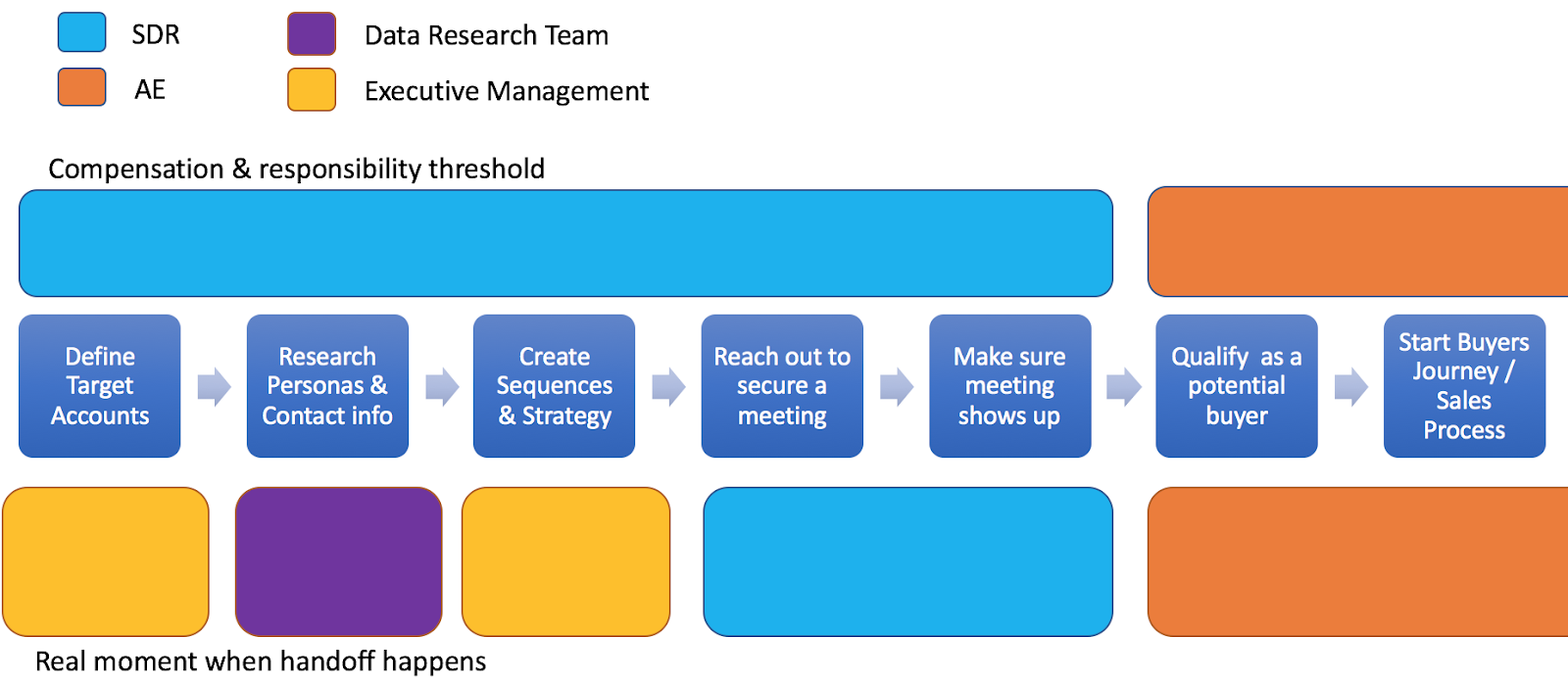Over the past few months, I’ve been constantly talking to VPs of Sales, SDR leaders, and SDRs themselves. One constant struggle I hear is the SDR to AE handoff. The problem is mostly centered around accountability, process and compensation. In this article, I’ll analyze the core issues that are deeply rooted within the SDR AE handoff process, and propose a few actionable solutions to address it, along with general best practices to follow.
Note: My perspective is from an organization that uses mostly Outbound SDRs. Small changes may be needed to adapt this to inbound.
Related: PODCAST 22: Being a Successful Account Executive — There’s More to it Than Hitting Quota
SDR vs AE: Vicious Cycle of Blame

The main problem I hear is finger-pointing. This is especially apparent on teams where there is a pod system and SDRs are paired to AEs, but it can happen on any team regardless of the setup.
SDRs complain that the AEs handling their demos are not as good as other AEs, and that’s why their opportunities aren’t moving forward.
The AEs on the other hand complain that the SDRs are just sending unqualified demos and therefore they aren’t on track to hit quota.
Who’s responsible? How do you fix this?
Step 1: Addressing Compensation & Pipeline Structure

Here’s the problem with most (not all) outbound setups.
They use some sort of data provider and give SDRs 500 accounts. Those accounts aren’t really qualified as the data might be coming from Mattermark or Datanyze.
The company data there, from my experience at least, is horrible.
The SDR starts the process there, spending several hours a week finding accounts first, then researching contacts, and creating sequences.
As a result, SDRs have little time to execute those sequences and are desperately trying to secure meetings that need to show up (meetings performed / held).
This is when the real handoff happens. However, this is not when the SDR gets paid commission – a result of a fundamental breakdown in the sales compensation structure.
Here’s an illustration of this:

In most companies, they have the AE ‘qualify’ the meeting as valid and move it to their Pipeline. If the meeting doesn’t move to pipeline, too bad SDR, you don’t get paid.
Step 2: Diagnosing The Disconnect: Are AEs Abusing Their “Qualification” Power?

When we look at that image above, we can immediately see the disconnect.
The real handoff happens at the moment the meeting starts, yet the responsibility shift, doesn’t happen until the AE determines that the opportunity is “qualified.”
Since the AE is the one who determines what is qualified, there is a power dynamics imbalance.
The AE’s best interest is to keep deal opportunities as long as possible in the “qualifying a prospect” stage because they are not held responsible for those, and it doesn’t affect their close rates or perception of performance. This obviously creates a very unfavorable scenario for SDRs.
Once they are sure they actually can close them, they move them to start the Buyers Journey, and finally the SDR gets paid for it.
This is the problem, and it must be resolved at the leadership level.
Step 3: Identifying The “Death Zone”
The “Death Zone” is called that way because the SDR can’t do anything to move the opportunity forward, and the AE, has no incentive to do so. The opportunity is dead, and both teams blame one another.
Before you react, keep reading, because there are a few solutions:

The Solution(s) For Fixing the SDR to AE Handoff Once and For All!
At a high level, here is an overview of important steps to take.
- Create an SLA + Committee Review.
- Clearly define your pipeline stages.
- Clearly define what constitutes an official “opportunity.”
- Create a process to define and review “disqualified opportunities.”
- Reduce (ideally eliminate) manual tasks that decrease SDR efficiency.
- Ensure your executive team is defining target accounts, NOT your SDRs.
- Accept Reality: your SDRs hate doing research – stop making them do it.
- Consider hiring a Lead Research team to optimize the sales process.
- Have your Executive Management build the sequences and analyze metrics.
If many, (or all) of the elements listed above are causing breakdowns in your sales process, it may be time for a deep dive sales process audit to address and remedy your issues.
Solution 1: Create an SLA + Committee Review

The first step to solving this is to create a Service Level Agreement (SLA) between Sales Development and Sales. This document will determine what is a qualified and unqualified meeting. The factors must be specific and binary.
That means that you should use qualification criteria such as:
- They use Salesforce
- They have at least 500 employees
- They are an e-commerce company
- The meeting is with a Director or above
However, you can’t use criteria that is ambiguous such as:
- The prospect is interested
- They have “pain” or “need”
What this solution does, is introduce a “System” that qualifies the Opportunity rather than leaving it to the AEs judgment. Now the AE has no ability to disqualify an opportunity because they don’t want to take responsibility for it.
Every opportunity that is performed and passes the SLA criteria falls under the AEs responsibility and is checked by their manager (VP) during the 1:1 meetings.
The problem is fixed!
The SDRs still need to create opportunities that pass the qualification criteria, and now the AE has no incentive to leave opportunities in the early stages as it is common practice is broken organizations.
See the illustration below…

In theory, this works.
However, you must remember that you need to enforce the fact that the qualification is done by an SDR and not the AE.
Since the AE would still have to talk to the prospect and determine if they are qualified, you need to review every opportunity that is marked as “not qualified” by an AE and make sure they are abiding by the SLA.
Boom!
Solution 2: Reduce (Ideally Eliminate) Manual Tasks That Decrease SDR Efficiency

If you go back to our first illustration, you’ll see that the SDR is just being given Accounts and it’s up to them to find the data, create the sequences, and schedule meetings with “qualified opportunities” that will pass the SLA criteria.
However, companies that overload their reps with too many tasks, overwhelm them and make them less productive.
I’m not surprised to hear that in many companies the number of manual activities (not counting automated emails) is under 60 per day per SDR, sometimes under 40.
Even worse, most companies count a voicemail as 2 activities (a call and a voicemail). You’ll never be able to scale this.
Moreover, what do the SDRs know about writing sequences? Very little.
Why would you give a task of researching leads to an employee that costs $100K/year? I seriously don’t know.
If you are allowing your SDRs to “build their own” sequences on Outreach.io or SalesLoft, you’re in for a world of trouble. I’ll write another post on that soon.
In the meantime, the best way to set up your team is to understand who is the best-qualified person at your company to execute the tasks needed during the Sales Development process.
Here’s how we do it at AltiSales:

From this illustration you can see that the SDR role is reduced to two tasks, reaching out, and making sure the meetings show up. Management and a “Data Research” team take care of the first steps… WTF, why?
Solution 3: Make Sure Your Executive Team is Defining Target Accounts, Not Your SDRs

There is no better team than your executive management to define the target accounts.
No, not your SDR manager, Executive Management!
Get your VP of Sales, maybe even your CEO and your top-performing AEs to analyze all the deals you have closed and determine your Ideal Customer Profile (ICP).
These are the company characteristics that make someone qualified, and the Buyer Persona, which are the characteristics of the person at that company that could buy or heavily influence the purchase of your solution.
After that has been defined, hire and manage an outsourced team.
Find highly skilled labor abroad, that can follow a simple and repetitive process of copy-pasting data from Linkedin, ZoomInfo or any other sources that you use.
Then have your executive management team build those outreach sequences (I’ll explain why in my next article, but trust me), and finally, have your SDRs only work on executing.
My SDR team’s minimum daily activity is 100 tasks completed. This counts voicemails still as just 1 task. Our usual activity is 85-100 calls and 20-30 manual emails (another 100 emails are automatically sent per SDR as well).
A few top performers on my team make over 125 calls per day.
Accepting Reality: Your SDRs Hate Doing Research

Did I read your mind? You will probably tell me that “forcing SDRs to make over 100 calls is inhuman” and that it will “skyrocket turnover and team morale”…
I’ve heard you, but don’t debate against me. Ask your SDRs. Their least favorite part of the job is to do the lead research. The most stressful is trying to figure out what emails work, and how to make effective cold calls. They want the guidance and training necessary to perform well.
My top SDR books 46 meetings in one month with VPs and Directors of Mid-Market companies. We tend to outperform other teams by 2-7x.
Important Steps We’ve Implemented:
- All our managers are required to be experts at cold calling.
- We teach SDRs how to talk on the phone and build a pipeline.
- We stress outbound skills are necessary for a future management position.
- We show our SDRs how to perfect cold calling within 6-12 months.
- Our managers listen to 100% of call recordings from each SDR during their first 6 weeks as employees and then listen to 20-30% of calls thereafter according to how the metrics for each employee look.
Since everyone is on the phone, there’s no such thing as silent SDRs because they are “doing research.”
The excuses are gone, the performance is up.
Notable Advocates Of This Outbound Process

While investigating how other companies handle this process in the past I found other leaders that align with what I have shared here, here are their comments about how to do this in Salesforce:
“SDRs create the meeting. If meeting does not occur then the SDR owns it until it does. AEs should have defined criteria which allows them to convert the first meeting to an opportunity” – Alan Tarkowski, Sr. Dir. of Sales, Fortinet
“Omit stage 0 from your win rate and calculation of pipeline. Everything starts at stage 1. This also makes it easy to track SDR conversion = % of stage 0 that get to stage 1.” – Emmanuelle Skala, VP of Customer Success, Toast
“If the win rate isn’t where it should be, the way to fix it is to tweak your SDR qualifying or first AE interaction.” – Mark Kosoglow, VP of Sales, Outreach.io
“We moved to an [SLA] where the SDR sets a task action for a future date in SFDC and assigns it to an AE. The AE marks the appointment complete once the meeting happens.” – Phil Keene, Dir. Sales, Costello







